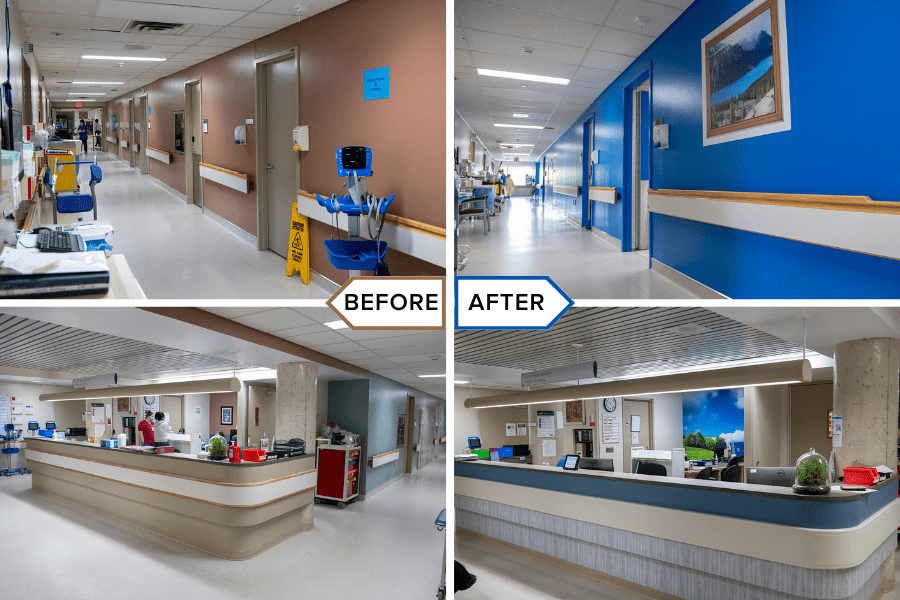
As soon as you walk into Kingston Health Sciences Centre’s (KHSC) Davies 5 unit, you notice how different the atmosphere is compared to other hospital units.
Brown hallway walls have been painted bright blue and unnecessary hospital signage has been replaced with artwork you may see in someone’s home. The care desk, once all in beige, now has three colours, making it easily recognizable, and has a nature-themed decal behind it and a plant terrarium on top.
The Davies 5 team provides specialty care for people, many seniors, who are waiting to transition from the hospital to living environments that best meet their needs, such as an off-site transitional care unit, a rehabilitation facility, a long-term care home, a retirement home, a group home or their own homes with supports in place to help them manage the activities of daily life.
“The experience of being in the hospital can be scary for seniors with memory difficulties,” says Dr. Rasika Wijeratne, an attending physician on the 28-bed unit. “An environment that looks and feels like home can bring them a level of reassurance that naturally enables them to more effectively participate in their journeys to recovery.”
The physical changes on the unit such as vinyl wrapping the doors of the activities room to make them look like a home’s wooden doors are not the only improvements, the care team has worked together to enhance how they care for patients.
“Person-centred care delivered with a whole lot of compassion has always been a strength of the care team on Davies 5,” says the unit’s program manager Jaima Gilchrist. “Recognizing there is always room for improvement, we made changes to make it easier for everyone on the team to do what they do best – provide high-quality, specialized care.”
Some of those changes include increasing the number of patient care assistants working during the day to help patients with their personal care and offer companionship, and bringing on a recreational therapist full time to engage patients in activities to help promote whole-person well-being.
“The addition of a recreational therapist has been the cherry on top,” says Dr. Wijeratne. “As a result of this initiative, we have seen less suffering and more enthusiastic engagement from patients."
Candice McMullen was the first person to take on the recreational therapist role, working in the unit this past summer. A typical day for McMullen and now current recreational therapist Jessica McCutcheon involves working with patients to plan one-on-one and group therapy sessions based on their interests and strengths.
“Whether we are engaged in beauty time, cognitive and physical games, walking outdoors or reading play scripts, we have a lot of fun,” says McMullen.
Gilchrist says the fun stuff is combined with simple enhancements patients experience on a daily basis such as whiteboards in patients’ rooms that clearly communicate patients’ likes and dislikes.
Care team members, upon entering a person’s room, can quickly look at the whiteboard and gain insight into how they can make their interactions with a patient more person-centred.
Taking the time to know someone likes to be referred to by a nickname or they don’t like mornings along with the other human touches recently introduced are some of the ways KHSC demonstrates that meaningful care matters.
Gallery



Updated activities room, including vinyl-wrapped doors to look like a home's wooden doors.

Recreational therapist works with patients to plan one-on-one and group therapy sessions based on their interests and strengths.



